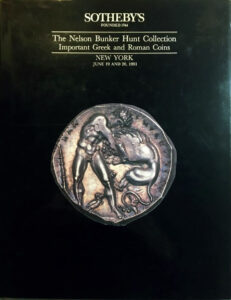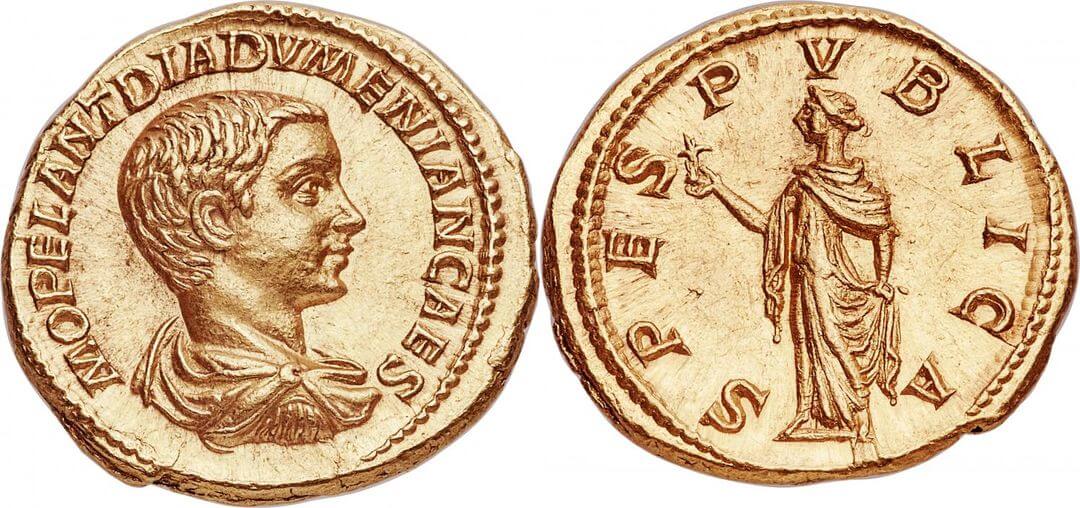Hunt, Nelson Bunker (1926-2014)
by Hadrien Rambach
Bunker Hunt, and his brother William Herbert Hunt (b. 1929), were the sons of a magnate who had founded the firm Placid Oil. Bunker “took over [the family business and] extended the oil business into Pakistan and Libya; where the world’s largest oil field was discovered on the tract of land licensed to the Hunts [who lost it when Colonel Gaddafi took power]. This was an oil prospector’s dream come true. In 1961, Bunker’s half interest in this tract was valued at about $7 billion, making him the richest private individual in the world – at age thirty-five. During the 1970s, the Hunts diversified, adding to oil an interest in real estate (5 million acres at one point), cattle, sugar, pizza parlors – and silver. Inflation was high in the 1970s and gold could not be held by private citizens at that time, so the Hunts began to buy silver in enormous quantitites” (Watson and Todeschini).
The two brothers started to speculate from the 1970s onwards on the silver market attempting to corner the market, resulting in estimated holdings of a hundred million troy ounces by 1979. The price of silver crashed in March 1980, “when the Hunts and their colleagues owned 200 million ounces, equivalent to half the world’s deliverable supply” (Watson and Todeschini), and the brothers’s sustained huge losses when the silver market backfired in the so-called “Silver Thursday” scandal, which saw them unable to meet their obligations as a consequence of COMEX’s decision to change the leverage rules on the purchase of commodities on margin. Though momentarily saved by a consortium of banks brought in to rescue the situation, the brothers lost over a billion dollars in the affair. The final blow came in 1988, when they were forced to pay 134 million dollars in compensation to a Peruvian mining company, and N.B. Hunt filed for bankruptcy in September 1988: he settled in 1989 for a ten million dollar fine with the U.S. Commodity Futures Trading Commission, in addition to other sanctions. Despite the bankruptcy, each brother was able to keep oil companies that were protected from their creditors through a trust-system and which were valued at over $150 million each. In 2013, W.H. Hunt was once again in the Bloomberg Billionaires Index – with a fortune estimated at $4.2 billion thanks to the sale of Petro-Hunt llc to Houston-based Halcon Resources Corp.

After the Hunt brothers went bankrupt, Sotheby’s New York organised two sales of ancient coins in 1990. But the material filled even more auctions yet to come.
Bunker Hunt started to buy coins in 1979, after meeting Bruce McNall, the founder of Numismatic Fine Arts, through horse-breeding. McNall soon convinced him to buy for 16 million dollars (half in cash and half in racehorses) the coin collection of Sy Weintraub (1923-2000), a film producer who quadrupled his investment. Bunker’s own ambition with the silver market was reflected in William’s wish to buy every Byzantine gold coin in the world. The Hunt brothers were peculiar collectors, in that they entrusted their advisors at NFA with the creation of their collection almost entirely. Following their various fines, and then the bankruptcy, Sotheby’s New York organised two auctions of ancient coins in June 1990, two more in December 1990, and two final ones in June 1991: suffice to say that clients who met them at the gala dinner preceeding the first auction were surprised at their superficial knowledge of their own coins. For them, race horse breeding was a bigger business than coins: when facing creditors, Bunker Hunt sold his stable for $47 million in September 1987. A third brother, Lamar Hunt (1932-2006), also speculated on the silver market but did not get involved with coins.

Ptolemaic Kings of Egypt. Berenike II, wife of Ptolemy III. Dekadrachm, c. 244/3-221 BC. Ex Hunt Collection. From Classical Numismatic Group Triton XIX (2016), 2103.
McNall wrote that Hunt’s desire to buy coins came from a distrust of ‘paper money’, caused by the fear of “a communist takeover of the United States aided by a Jewish conspiracy inside the government”. Something to take into account, when judging the evolution of coin prices, is the world’s economy at the time. For example, the surprisingly great success of an auction such as the Gilet ‘Kunstfreund’ sale may be explained by an inflation of 11% per annum. which led investors to search for hard assets. At the height of Hunt’s silver-buying frenzy, inflation had almost reached 20% yearly.
Bibliography:
- Bruce McNall, Fun while it lasted, New York 2003, pp. 53 sqq.
- Hadrien Rambach, “Provenance glossary”, in Numismatica Ars Classica, Auction 91: the George W. La Borde collection of Roman aurei – part I, Zurich, 23 May 2016, pp. [67]-[79].
- Hadrien Rambach, “Provenance glossary”, in Numismatica Ars Classica, Auction 99: the George W. La Borde collection of Roman aurei – part II, Zurich, 29 May 2017, pp. 47-63.
- Hadrien Rambach, “Provenance glossary”, in Numismatica Ars Classica, Auction 105: the George W. La Borde collection of Roman aurei – part III, Zurich, 9 May 2018, pp. 82-105.
- Peter Watson and Cecilia Todeschini, The Medici Conspiracy. The illicit journey of looted antiquities from Italy’s tomb raiders to the world’s greatest museums, 2nd ed., New York 2007, p. 74, p. 129.
This article was first published in a catalogue of auction house Numismatica Ars Classica.








